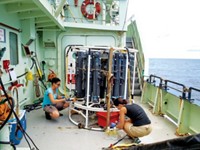Advertisement
Grab your lab coat. Let's get started
Welcome!
Welcome!
Create an account below to get 6 C&EN articles per month, receive newsletters and more - all free.
It seems this is your first time logging in online. Please enter the following information to continue.
As an ACS member you automatically get access to this site. All we need is few more details to create your reading experience.
Not you? Sign in with a different account.
Not you? Sign in with a different account.
ERROR 1
ERROR 1
ERROR 2
ERROR 2
ERROR 2
ERROR 2
ERROR 2
Password and Confirm password must match.
If you have an ACS member number, please enter it here so we can link this account to your membership. (optional)
ERROR 2
ACS values your privacy. By submitting your information, you are gaining access to C&EN and subscribing to our weekly newsletter. We use the information you provide to make your reading experience better, and we will never sell your data to third party members.
Environment
Air Pollution Sources From Gulf Oil Spill
by Cheryl Hogue
January 2, 2012
| A version of this story appeared in
Volume 90, Issue 1
Evaporation of hydrocarbons created more air pollution from the Deepwater Horizon oil spill than did burning oil on the surface of the Gulf of Mexico, according to a new study (Proc. Natl. Acad. Sci. USA, DOI: 10.1073/pnas.1110052108). Researchers, led by scientists from NOAA, analyzed air pollution created during the 2010 drilling rig disaster. The scientists found that about 8% (±4%) of the oil that reached the surface of the gulf eventually became tiny airborne particles. The mass of particulate matter from evaporating hydrocarbons was about 10 times that of the airborne soot created in controlled burns, which were set to reduce the size of the slicks and their effect on shorelines. Instruments detected a massive atmospheric plume of small organic particles and pollutant gases downwind of the spill site, says Ann M. Middlebrook, a NOAA scientist and lead author of the study. The study also revealed high levels of ground-level ozone downwind of the spill. Ozone can form from volatile organic compounds in the presence of sunlight.





Join the conversation
Contact the reporter
Submit a Letter to the Editor for publication
Engage with us on Twitter